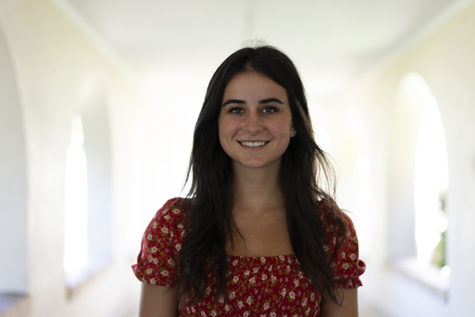Out With the Old
A new form of sexual violence prevention education in PAUSD.
As children, we are often shielded from some of life’s most problematic realities and given a glamorized depiction of life. As we grow older and gain independence, it becomes vital for us to have the proper tools and education to navigate these harsh truths.The #MeToo movement has encouraged thousands of women to speak up against sexual harassment and abuse, bringing our country a significant step forward with the awareness of these issues. As we continue to face the backlog of horrific tales, including those of Christine Blasey Ford, Rowena Chiu and Chanel Miller, the need for K-12 student sexual misconduct prevention education becomes more urgent — before it’s too late.
The first step towards lasting change is infiltrating our standard curriculums with an educational emphasis on sexual violence. Research from Stanford University and Johns Hopkins University shows that wherever consent education has been taught to girls, rape rates have decreased by half. Another study done by Stanford found that over half of 2,000 high school girls in Nairobi, who completed a self-defense course, had deflected sexual harassment or rape using techniques learned in class. Similarly, after taking the training, of the 35 percent of adolescent boys who witnessed a sexual assault in progress, three-quarters of them successfully intervened to stop it. It is evident that giving people access to this knowledge has not only helped them learn ways to protect themselves, but it has also taught people how to save the lives of anyone in danger. Many are also learning to save lives through intervention because of their newfound knowledge of ways to identify and address sexual assaults.
It was not until 2015 that Governor Jerry Brown signed a law that required all public schools in California to teach sexual education for students in grades 7-12, resulting in current seniors in the Palo Alto Unified School District not receiving sexual violence prevention education until they reached the high school level.
The standardized curriculum includes topics ranging from sexually transmitted diseases to sexual violence. Before this law passed, school districts had the freedom to choose whatever topics they wanted to teach, as long as they fell under the umbrella of sexual education.
Some districts took advantage of this flexibility and the lack of a state law mandating the instruction of this education. For example, one district omitted the discussion of condoms from their curriculum, and another compared a dirty shoe to a non-virgin woman.
While many presume that law has improved sexual education in the state, they also believe that work still needs to be done for schools to have informative and productive discussions.
“We had the same presentation freshman year and sophomore year and I think it was good to have some education, but I don’t think it was the most effective way to do it because some people weren’t paying attention or just didn’t want to be there because it felt like they were being forced to go,” Paly junior Anna Mickelsen said. “It’s good that we have an education, but it should be done in a different way to be more effective.”
Current freshmen, sophomore and junior students at Paly voiced their concerns about the presentations they received in middle school. A popular consensus about these presentations is that their lightheartedness removed the importance and gravity of the topics.
“In eighth grade, we had this assembly where there was a play kind of thing with a cast of four adults showing different aspects of what was supposed to be like high school life,” Mickelsen said. “They were making jokes, and I think trying to relate to us, but it just made everyone distracted from the point of the show. They had some kind of song that was like a jingle, and I think that’s all anyone took away from it.”
Many find that discussions of sensitive topics are difficult to present in an appropriate way for different age groups. The concern of not maintaining an appropriate curriculum often creates ones that focuses on protecting youth from the severity of the topics, rather than expressing their relevancy and gravity to their true extent.
“I definitely think it would be more effective to show real examples of people our actual age and things that actually happened instead of sharing generic and extreme cases,” Mickelsen said. “Also, offering some sort of solution would be [more effective].”
According to the Centers for Disease Control and Prevention, an estimated one in six boys and one in four girls are sexually abused before the age of 18, but it doesn’t have to be this way. Children need techniques to challenge rape culture and to learn how to deal with inappropriate comments, unwanted touching, coercion and assault.
Max Pearson, a Paly senior, recognizes elementary school as the ideal time to begin age appropriate consent education. “With so many other essential principles being taught and retaught from such a young age, I see no reason that consent and sexual violence prevention can’t receive a similar treatment,” Pearson said.
“[In elementary school] I would get pinned up against the fence and threatened to be kissed against my will because a boy had a ‘crush’ on me.”
-Eva Salvatierra
Paly sophomore Eva Salvatierra recollects her visceral experiences as a young girl on the playground. “I would get pinned up against the fence and threatened to be kissed against my will because a boy had a ‘crush’ on me,” Salvatierra said. While many adults deem these actions as harmless, the acceptance of these behaviors can restrict these young minds from future consent education. “Once a generation has grown up with the concept and structure of a society of consent and empathy and boundaries then rape culture itself has little power over the minds of these children into adulthood,” Salvatierra said.
Mickelsen also believes starting consent education in elementary school will have a tremendous impact on the youth in our community. “They’ll grow up and become more comfortable with the topic so that when they get to high school, people will be talking about it more and they won’t be uncomfortable and they’ll actually take it in more,” Mickelsen said.
The RISE Task Force, standing for Responsive Inclusive Safe Environment, is a group of district members, administration, teachers, parents, and students. Established in the fall of 2015 by acting Superintendent Karen Hendricks, RISE aims to promote a culture in which sexual assault, harassment, and violence are not tolerated. The task force has had many initiatives in the past five years, most notably bringing in educational speakers to the PAUSD middle schools and high schools.
Last year, RISE brought Anea Bogue—an expert on sexual misconduct prevention education—into PAUSD. Bogue’s sexual misconduct prevention education strategies aim to help schools achieve a culture of consent and to aid students in creating healthy relationships with everyone in their lives. During the 2018-2019 school year, Bogue gave 80-minute presentations to grades eight through 12 in PAUSD. “[This presentation] can be a reasonably effective way to get core content on the minds of an entire student body over the course of a couple of days,” Bogue said.
This year, Bogue is altering the form in which PAUSD students receive consent education. “My goals for this year are to expand and deepen the conversation around consent,” Bogue said. The education this year will be heavily focused on teaching students how to have healthy relationships with themselves and others. To design this new educational method, Bogue has been receiving input from both Paly students and teachers on what is most meaningful and impactful for students to learn. “Our conversations with teachers, counselors and students are pointing very strongly to the benefits of broadened learning opportunities,” Bogue said.
Although Bogue has proposed four 40-minute interactive workshops that will do a deeper dive into consent, the content of these workshops won’t be finalized until she has analyzed and uncoordinated the suggestions and input from PAUSD teachers, counselors, administrators and students.
“We also want to incorporate real-life experiences and case studies that students can relate to and take seriously…”
-Anea Bogue
Bogue is additionally working on bringing more seriousness through hands-on workshops, as many students have suggested. “We also want to incorporate real-life experiences and case studies that students can relate to and take seriously as they ‘unpack’ them to gain a better understanding of what happened and why,” Bogue said.
Along with Bogue’s work with PAUSD students in grades eight through 12, district members—most notably Karen Hendricks—are determined to bring consent education to younger students in the school district for the 2020-2021 school year. As of now, there is a 45-minute lesson planned for 6th graders during orientation and 7th graders will be receiving two 30 minute consent lessons.
While there is not a specific consent education curriculum for elementary school students, these young students are still being brought aware of these important concepts. “Teachers are constantly teaching students about personal space, body awareness, empathy, how to recognize feelings and communicate those feelings and needs to others, who to go to at school for help, and how to be an upstander,” Anne Brown, the PAUSD Assistant Superintendent of Elementary Education Services, said. These schools are also bringing more focus to social emotional learning (SEL). “Some of the SEL programs used at our elementary sites are Responsive Classroom, Project Cornerstone, Project Resilience, PlayWorks, Expect Respect, Social Thinking and Life Skills,” Brown said.
John Fitton, a Paly parent and RISE District Task Force member, believes these positive steps forward in consent education will have an effective impact on youth in the Palo Alto community. “Creating a way to deal with things that knock you down in life is almost as important, and sometimes more important, than the actual academic experience that we focus so strongly on in this community,” Fitton said.
Along with this, Fitton wants to bring attention to the imperative role adults play in educating the youth about these concepts. “It’s the responsibility of the adults to provide leadership and then include student voices, to again make things better and to teach and increase awareness towards safety and towards empowerment,” Fitton said.
The Palo Alto Unified School District is acknowledging the necessity of these imperative lessons. Their ultimate goal this year is to create consensual campus environments, while empowering students to work towards having healthy relationships. The creators of the curriculum—Anea Bogue, district members, administration, teachers, students—have devoted their time to creating effective education for PAUSD students; they hope all youth will take advantage of this opportunity to gain crucial tools that will aid them in creating safe environments for themselves and others throughout the rest of their lives.
Art by: Ellen Chung

2019-2020 - Staff Writer
2020-2021 - Managing Editor
I joined C Mag because of the fun spreads, creative designs, and interesting story topics!...

Katherine joined C Magazine because she was amazed by the creative designs as well as interesting text the magazine continuously presents. She love the...







